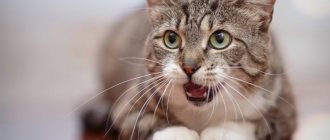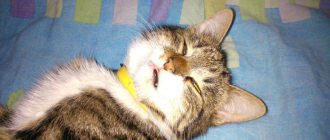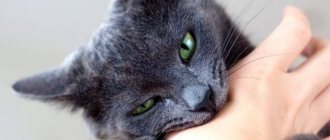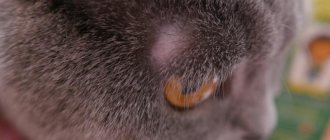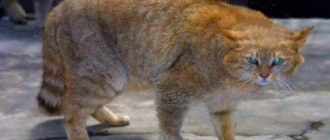VETERINARIAN IRINA BARABASH
Owners sometimes observe a kitten or adult cat trembling. If this happens rarely, it is not a cause for concern. The owners blame everything on chance or cold. However, some pathologies that first appear as tremors later cause seizures in the cat, and this can end sadly. In addition, there are diseases with such symptoms that are dangerous to humans. Therefore, trembling in cats cannot be ignored - you should immediately contact a veterinarian. And the MURKOTIKI website will tell you about the possible causes of the symptom.
Reasons why a cat may tremble
Trembling, or in other words tremor, is a condition indicating contraction of muscle fibers. If a cat is trembling, this does not always indicate the development of pathology. The main causes of trembling in a cat are:
- Specific reaction of the body to cold . A cat may shiver after a bath or after long walks outside during the cold season. Tremors can be caused by severe hypothermia of the body during prolonged exposure to the street, or by a slight decrease in temperature when the room is cool. You can prevent your pet from trembling as a result of hypothermia by avoiding long walks in the cold. Cats with short hair or hairless breeds get cold especially often. Owners of such pets should take more careful care of their animals.
- Stressful state. Trembling in a cat may appear as a response to a strong emotional outburst or stress. The appearance of tremors in a cat may be associated with the appearance of new animals in the house, or when transporting the pet in a carrier. At the same time, the cat's tail shakes, thus the animal signals its nervous state. You can eliminate tremors by preventing the development of stress in your cat and calming it as much as possible.
- Sexual arousal . During the period of sexual heat, a cat may experience characteristic trembling against the background of a hormonal surge. During a cat's heat, all of its senses are heightened, they react more vividly to various smells, and may behave strangely and restlessly. This condition in a cat can be prevented by timely surgical intervention to remove the reproductive function.
- Natural biochemical processes in the body . While the animal is resting, the body continues its work. Biological processes actively occur in the body of a sleeping cat, accompanied by trembling during sleep in the entire body, or some parts. Thus, it has been observed that not only dogs, but also cats are capable of shaking their hind legs in their sleep.
Tremors can also be caused by dangerous pathological changes and serious illnesses. Thus, in the absence of a properly balanced diet for an animal with a pronounced deficiency of essential vitamin and mineral complexes, degenerative processes develop.
It has a particularly acute effect on the appearance of tremors in a cat, a disturbance in the absorption and flow of calcium into the body. Such violations can be prevented by carefully choosing a diet that is balanced with all the necessary nutrients.
Trembling in a domestic cat can also develop against the background of such a dangerous viral infection as rhinotracheitis. The pathology is accompanied by serious damage to the organs of vision and respiratory tract. Lack of assistance during the development of the disease can cause serious complications, in some cases threatening the normal functioning of the pet.
Another reason for the appearance of tremors in cats is the presence of internal parasites (helminthiasis).
The appearance of trembling in a cat after surgery is a fairly common occurrence and is not evidence of a pathological condition. When a cat shakes after sterilization, this indicates that the body is emerging from a state of anesthesia (deep sleep) and is coping with the remnants of anesthesia.
The first few hours after the sterilization operation, tremors in the pet’s body are normal. If the cat trembles after sterilization for a long time (more than 6 hours in a row), you should consult a veterinarian. This is due to the fact that such trembling may indicate the development of internal bleeding.
This is interesting: What to do if a kitten bites your hands?
Reasons Why Kittens May Shake
Let's look at 13 popular reasons why a kitten may be shaking:
- Staying in a cold room or outside in freezing temperatures.
It is believed that a comfortable air temperature for newborn kittens is +31 degrees, for older pets – about +24 degrees. If there is no heating in the room in winter or late autumn or the windows are wide open, then the room temperature can become significantly lower than 24 and even more so 31 degrees, which can lead to hypothermia and trembling in kittens. Other signs besides trembling that indicate that the cat is cold are drowsiness, apathy, slow breathing, rare pulse, low body temperature (in kittens less than 38.5 degrees). By the way, even in summer, in drafts, a kitten may tremble after bathing if it gets cold;
State of excitement.
Now we are not talking about sexual arousal, but about the reaction, for example, to delicious food. The kitten may also tremble during play, when it gets into a rage. Older kittens may tremble at the sight of a bird outside the window or, say, a dragonfly. Naturally, tremor in such cases is short-term and safe;
Movements in sleep.
Many owners have probably noticed that their kittens' paws tremble, lips move, and ears move during naps or deep sleep. That's right, because cats also dream, according to scientists. Moreover, the owner can even guess what exactly the purr is dreaming about. So, trembling may mean that the pet is having a bad dream (a harsh neighbor’s dog, for example), the movement of the paws means that in the dream the pet is running somewhere, and so on;
Fright.
If the kitten is trembling and meowing, trying to run away, if its fur is raised on end and its eyes are bulging, it may be simply scared. Small animals can become frightened by anything, for example, a noisy stranger or the loud noise of a vacuum cleaner;
Stress.
Anything can put a little purr out of action: a change of place of residence, early weaning from its mother, buying new rattling toys, and so on. When stressed, many kittens tremble, lick their fur furiously, eat poorly or excessively, and become overly affectionate or aloof;
Poor functioning of the digestive tract.
Some owners notice that their kitten trembles after eating. This is due to a strong contraction of the muscles of the stomach and intestines, as a rule, after eating solid food, which is too early for a baby kitten to eat;
Sexual desire.
When we talk about kittens, we mean not only tiny pets under 2 months of age, but also teenage animals over 5 months of age who are beginning to be interested in the opposite sex. During sexual heat, many cats and seals tremble, meow loudly, rub against furniture or the owner’s legs, females’ genital area swells, males place marks;
Description of trembling
The scientific term tremor is used to define shaking. Tremors are defined as rapid and rhythmic movements that are caused by muscle contractions. Trembling can be classified according to several criteria:
- in terms of speed, shaking can be fast and slow;
- by localization, tremor of the animal’s head, limbs, croup and generalized tremor are distinguished;
- By severity, it is customary to distinguish between mild tremor, which does not interfere with the animal’s eating, drinking and leading an active lifestyle, and severe, in which case independent movement and eating are difficult for the cat.
The shaking may occur when you are at rest (resting tremor) and disappear when you move or try to make a precise movement. Limbs may tremble when the animal tries to hold them in a certain position.
Main reasons
Fear or extreme fright
A common reason why a cat shakes with small tremors. The animal shudders nervously, shakes its tail, and breathes rapidly due to the release of adrenaline, the fear hormone, into the blood. Due to tension, a tremor develops, which goes away as soon as the animal calms down.
If your pet is cold
Sometimes trembling in a cat occurs as a reaction of the body to hypothermia. When an animal is cold, it trembles in different ways, for example, small. In this case, it is impossible to visually notice the trembling, but if you put your hand on the body, you can feel how it vibrates. If a cat's chills are noticeable to the naked eye, then the cat is trembling violently. Often this condition is observed after washing the fur, when the animal’s body and head are wet, it actively shakes them, but cannot warm up because the room is not warm enough. Hypothermia often occurs when a cat walks outside for a long time in winter in severe frosts. Once inside the house, the pet winces, its muscles tremble, its legs and tail shake.
Stormy emotions
Trembling in an animal occurs at the moment of fright, while the cat arches its back and shakes its tail.
During overexcitation, you can also notice that the cat is trembling all over its body. This reaction can occur to both negative and positive emotions. If an animal senses danger, adrenaline, the fear hormone, enters its blood. When walking, the cat shakes its tail, its back is arched; if its nerves are at the limit, you can notice how the eye twitches.
Many owners note that a pet’s tremor occurs during games, affection, or a long-awaited meeting with the owner. If the kitten trembles after eating, this is also normal. Experts explain this phenomenon by the fact that when an animal eats its favorite food, many muscle groups contract due to positive emotions, which is why trembling appears.
Hormonal surges
Heat is a common reason why a female cat or tom will shiver. The cat's sexual desire is so strong that the animal during this period becomes unlike itself. It constantly yells, does not eat, follows on the heels of its owner, shakes its paws, tail, and shifts its hind legs. From overexcitation there is a tremor of the head and back, chills can bother you even in your sleep. If the owner does not plan to breed offspring, it is better to save the four-legged friend from such suffering by castrating or sterilizing him.
Trembling when a cat sleeps
Animals, like people, can experience vivid dreams and even nightmares during deep sleep.
Therefore, if cats sleep, involuntarily jerking their legs, head, tail, this is considered the norm, because at this moment the animal experiences certain emotions that contribute to the contraction of muscle tissue. But when the pet wakes up, everything goes away. Sometimes support is required from the owner so that the cat can calm down and forget about the nightmare.
Diseases
Trembling can be a symptom of a dangerous disease in which the animal is bothered by tremors and chills. If a kitten or an adult cat constantly experiences trembling throughout the body, the following diseases may be occurring in the body:
- Rhinotracheitis. An infectious pathology that affects the eyes and respiratory organs, and if treatment is not timely, the musculoskeletal system is involved in the pathological process. The animal's temperature rises, the kitten is vomiting due to severe intoxication, and is also worried about tremors and fever.
- Helminthiasis. They often cause a cat's hind legs to shake.
- Renal dysfunction. A dangerous pathology that negatively affects the functioning of internal organs and systems. If your pet is trembling even when lying down, and there are problems with urination, it is better not to hesitate to visit a doctor.
- Epilepsy. A serious and dangerous disease that can begin to bother the animal as early as 2-3 months. During an attack, the pet is unconscious. Due to involuntary muscle contractions, the cat shakes its tail and head, its paw may tremble, its eyes become glassy, and the animal is completely disoriented.
- Exhaustion of the body. This condition is often observed due to poor nutrition, after a serious illness, or after surgery. A lack of vitamins causes the cat to tremble, so if such a symptom is bothersome, the owner should review the diet and give the pet additional vitamin supplements.
Pathological causes of head tremors in cats
If a cat's head twitches, then special attention should be paid to the health of the cat. In some cases, a veterinarian diagnoses serious illnesses. Common cat diseases include:
- Otodectosis. This cat disease is popularly called ear scabies. The animal develops parasites in the ear cavity. At the same time, the pet begins to actively shake its head and furiously scratch its ears with its paw. The causative agent is a small mite that bites into the tissue of the shell. The cat experiences severe itching, and while scratching it makes a plaintive meow. Upon careful examination of the ear cavity, the owner can identify abrasions and scratches. In the depths, black and brown discharge is recorded, consisting of dried blood and waste products of parasites. Banal cleaning of the ear canal does not have a positive result. The pet continues to experience extreme discomfort from otodectosis;
- Sulfur plug. The accumulation of wax forms plugs in the ear canal. The cat's hearing decreases and he begins to shake his head strangely, trying to remove the foreign particle;
- Otitis media. This is an inflammatory disease. The ears begin to hurt very much and fester. If your cat's head is trembling, and the animal does not allow you to examine the sore spot, then it may be a cold. The owners note a purulent odor from the ears and the discharge of a purulent mass. It is necessary to take your pet to a veterinarian;
- Diseases of a neurological nature. Tremor can be observed with encephalitis, stroke, dizziness, and head injury. In this case, you need to carefully monitor the pet’s behavior and its general condition. If accompanying symptoms are recorded, such as unsteadiness while walking, movements in a circle, pupils of different sizes, diagnostics in the clinic is required;
- Liver, kidney or multiple organ failure. The condition clearly indicates a failure in the normal functioning of the organ. This disease is very difficult for pets to tolerate. In this state, the cat jerks its head strangely. The pathology leads to the death of the four-legged friend. Tremor occurs in most cases in the last stages, before which the animal feels unwell and its former activity disappears. At the first sign, you need to take your pet to the veterinary clinic.
The cat is shaking - the main reasons
Tremor (whole body trembling) is a rhythmic muscle contraction caused by internal or external factors, such as:
- change in temperature,
- reaction to stressful situations,
- sexual arousal,
- pathology.
- Cold, heat.
If the animal begins to tremble, having wet its skin, this behavior is normal. The furry predator is able to withstand low air temperatures, but does not tolerate humidity well.
The problem is especially urgent for a kitten; self-regulation of the body in babies is still weak, they are especially sensitive to humidity, but the development of seizures indicates a serious illness. Overheating of the body can lead to heatstroke, which in turn leads to tremors.
- Fear.
Attentive owners notice that the pet’s behavior when seeing unfamiliar people or things looks like this: the body begins to shake from small tremors. Fear of the unknown, especially fear, causes symptoms such as tremors of the limbs and involuntary urination.
- Emotional excitement.
Strong emotions (negative or positive) can cause involuntary muscle contractions. The cat is trembling not because of poor health, but from joy after a long separation from the owner, and so on.
- The period of sexual hunting.
An animal in heat often trembles when it sees an individual of the opposite sex. The hormonal surge that begins when looking at a potential partner leads to trembling. If trembling occurs in an animal after sterilization, you should have your pet checked by a veterinarian.
Be sure to read:
Discharge in a cat: what does it mean, causes, norm and pathology, what to do, how to treat
Symptomatic treatment
Therapeutic methods for physiological sources of the problem:
- hypothermia - the animal is warmed up, a light massage is performed, and the wet fur is dried with a towel after washing;
- overheating - cooling with compresses, the cat is allowed to drink on demand;
- stress - removing the source of fear, creating peace and quiet;
- sexual arousal is suppressed with special drugs.
Treatment of the pathological origin of muscle tremors is carried out with antibacterial agents, replenishment of vitamin and mineral deficiencies, and operations to remove tumors.
Furry pets are in excellent health; if the cat begins to shake with small tremors, then you need to undergo a diagnostic examination and find out the original source of the abnormal condition. Ignoring the problem can lead to the development of unpredictable consequences for the health of the animal.
Video
What treatment is prescribed?
After making a diagnosis, the veterinarian will tell you what to do next and prescribe an individual treatment regimen. Tremor that occurs for physiological reasons does not require special treatment. The animal should be protected from stress factors and ensure that it is less nervous and worried. To prevent your cat from suffering from tremors and hormonal surges during the period of estrus, you should take care of finding a partner in advance, and if breeding offspring is not included in your plans, then it is recommended to undergo sterilization surgery.
In addition to basic treatment, it is important to include vitamin supplements in your pet’s diet that will help strengthen the immune system.
If the root cause of tremors is any internal pathology, a comprehensive treatment regimen is prescribed to get rid of the original source of the problem. In addition to taking medications, the owner should take care of the nutrition of his four-legged friend. After all, if a cat eats low-quality food, this also negatively affects its health and causes tremors. If there are problems with the kidneys and organs of the urinary system, experts advise switching the cat to holistic food. In addition, after consulting with a veterinarian, it is useful to periodically give your pet special vitamin and mineral supplements that support the immune system and increase the body’s resistance to the effects of negative external factors.
This is interesting: How to accustom a cat to your hands?
What to do if your cat is shaking
If an animal exhibits involuntary trembling, the owner should:
- analyze previous events,
- exclude external factors (hypothermia, overheating, fear, sexual overstimulation),
- contact a veterinarian to diagnose the disease and begin treatment in time.
Do you know what to do if your pet is shaking due to external reasons?
- In case of hypothermia, warm the animal, dry the skin, and massage the body.
- In case of overheating, cool the body with cool compresses and inject water into the oral cavity from a syringe without a needle.
- In case of stress, calm the pet down and protect it from objects that cause fear.
- During sexual hunting, you need to carefully monitor the pet’s condition and give medications that reduce attraction to the opposite sex.
When to contact a veterinarian
When a cat trembles as a result of a pathological condition and the tremor is not associated with physiological processes, it is necessary to show the pet to a veterinary specialist. This will allow you to quickly determine the cause of the pathology and prescribe adequate appropriate treatment.
Quite common pathologies diagnosed in domestic cats in veterinary medicine are:
- The cat is shaking with small tremors due to a herpes virus infection or rhinotracheitis virus. In addition to trembling, the animal experiences discharge from the eye area and respiratory tract, a characteristic cough and attacks of eruption of gastric contents.
- The cat trembles all over with helminthiasis, which threatens the life of the animal. Infection with dangerous helminths is accompanied by processes of intoxication of the body, provoking the development of tremor. In some cases, trembling is not observed in the entire body, but only in the hind or forelimbs.
- Inflammatory process in the bladder. Cystitis causes pain during the act of urination, which leads to tremors from pain. The same symptom appears in domestic cats with the development of urolithiasis.
- Ear diseases - various otitis and otodectosis - cause itching and discomfort in the cat, causing tremors (the cat shakes its head). In the absence of timely treatment, the pet may lose hearing, and in the most dangerous cases, when the eardrum is perforated due to bacterial otitis, the membranes of the brain may become infected.
- The appearance of trembling in the head area may indicate not only damage to the ear canal. As a rule, the cause of head tremor and tremors in the body can be encephalitis, pathologies of the cerebellum, and dangerous injuries to the skull.
- Tremor in the sacral region can be a signal of disorders in the spine caused by compression fractures, tumor processes, and deformations in the intervertebral discs.
If the cat trembles after sterilization for a long period of time, the animal’s condition is not stable, and it refuses water, then in such cases it is necessary to contact a veterinarian and take the pet to the clinic.
A dangerous condition accompanied by tremors in the body is acute intoxication of the body with salts of heavy metals or the entry of a foreign body into the digestive system. The pet begins to arch its body, scream and meow pitifully.
Trembling is also accompanied by pathological processes in the neuromuscular plane, caused by an acute lack of nutrients in the diet. Metabolic processes, intoxication and other health-threatening factors may also be the cause.
Depending on the reasons that caused tremors in the cat’s body, the veterinarian prescribes an individual treatment regimen based on the patient’s body weight, age and the presence of chronic diseases. It is important to remember that trembling in a cat’s body is not a disease, but just a signal from the body. The veterinarian's job is to determine the root cause and eliminate it. The sooner the doctor discovers the cause of the tremor, the sooner treatment will begin, and the prognosis for the cat’s recovery will be favorable.
The cat is shaking long after surgery
To prevent this from happening, you need to treat your pet only positively and affectionately.
If your cat is trembling, and you don’t care about it, then don’t talk about it, the pet has changed in behavior and has begun to irritate you. There is no need to leave the cat in this situation. It needs to be solved!
As you already understand, short-term trembling that goes away over time is not dangerous. However, if the cat is shaking for a long time, then this sign signals problems
Important!
If you discover this symptom and it does not go away, you should immediately contact a veterinary clinic to determine the causes and timely treatment.
Trembling a day after surgery is a sure sign that there are some problems. Perhaps the symptom is caused by a fever, which was provoked by an inflammatory process that began in the body.
If the matter is really inflammation, then the following symptoms will indicate this:
- suture swelling;
- discharge of ichor, pus from the wound;
- the appearance of vomiting;
- apathy and indifference of the animal.
READ How many days do cats walk depending on their breed?
If trembling is accompanied by any of the above symptoms, you should definitely visit a veterinarian. Only after an examination will he be able to make a diagnosis and prescribe the necessary treatment.
Lack of vitamins
Convulsions and tremors can be caused by a lack of vitamins in the body, namely magnesium, calcium or vitamin B. Usually, improvements occur after the missing vitamins are added to the pet’s diet. The required course is about 10 days.
Interesting!
Veterinarians advise adding brewer's yeast to your pet's diet in order to provide her with the necessary amount of vitamin B. Consult your doctor about this step.
Sometimes cats that have just been spayed may flinch after physical activity. This process is similar to how a person’s legs shake after running. With the same success, trembling goes away after some time in cats. However, if the pet has rested, but the trembling has not gone away, then this is a reason to visit the veterinarian.
When to see a doctor
If a cat's tremor is accompanied by fever, indigestion or pain, the animal must be urgently taken to the clinic or a veterinarian called to your home.
Also, a cat whose trembling turns into convulsions or epileptic attacks requires immediate hospitalization.
Sometimes the owner cannot understand why a kitten or an adult cat is shaking violently, and at the same time she arches her back, meows quietly, and tries to burp. Such signs usually indicate ingestion of a foreign object that is causing pain or discomfort. In this case, the animal can only be saved in a clinical setting if the object is surgically removed in a timely manner.
The cat's head is twitching - is this a reason to contact a specialist?
Owners of four-legged pets sometimes notice characteristic head twitching.
Pets can make such movements absolutely naturally and consciously. In some cases, small movements are involuntary and indicate a pathological condition of the animal that requires attention and treatment.
When a cat's head twitches, it may just be getting ready to jump. Such movements are typical for a furry pet before concentration and sudden action. At the same time, you can notice that the cat presses itself to the ground and begins to twist its croup (it may not twist), the animal’s eyes rotate with concentration following the object of interest to it, and its head makes small movements similar to shaking. Head shaking during sexual arousal is not a deviation either. The cats begin to jerk their heads slightly, and then the shaking is transmitted throughout the body. But if the animal does not have the above signs, then tremor may indicate developing pathologies.
Diagnostics
You can decide what to do if a kitten or adult cat is trembling only after determining the causes of the tremor. In most cases, it is impossible to do this yourself at home. However, you need to carefully monitor the animal’s behavior in order to answer the following questions for your veterinarian:
- frequency of repetitions and duration of attacks during the day;
- the presence of accompanying symptoms;
- events preceding the onset of tremor;
- dates of the last deworming and vaccination.
It is also necessary to remember whether the cat was bitten by a tick during the year.
To make an accurate diagnosis, the following studies may be prescribed:
- general and clinical blood test;
- Analysis of urine;
- fecal analysis for the presence of helminths;
- radiography of the head, spine, chest and abdominal cavity;
- MRI or CT scan of the brain;
- myelography – to detect spinal tumors and intervertebral disc pathologies;
- electromyography.
A cerebrospinal fluid tap may be taken to confirm encephalitis.
Conclusion
Sterilization is a routine operation and complications after it are extremely rare. After surgery, it is important to monitor the cat’s condition so as not to miss alarming symptoms and prevent severe inflammation. Remember, the sooner you discover something is wrong, the easier it will be to cure your pet and avoid negative consequences. Treat your cat with care and this will help her get better faster.
If the owner notices that the cat’s paws are shaking, then it is necessary to urgently visit a veterinarian. This phenomenon should not be ignored. It also happens that a cat’s hind legs are shaking, but the front legs are not affected by the disorder. The tremors in the hind limbs that your cat suffers from will not go away on their own.
If you start a violation, then there is a danger that gradually the paws, which at first only shake, will begin to fail, and the cat will simply end up half paralyzed, forced to lie down all the time. No owner would want such an outcome, and therefore, naturally, will make every effort to restore the normal state of the pet. It is important to know that when the paws shake, the trembling in them is not a cramp.
When asked why the owner sometimes notices tremors in the limbs of a kitten or an adult pet, the answer can be completely different, since the reasons range from harmless to pathological.
Treatment
Physiological tremor in cats does not require medical intervention. To eliminate it, it is enough to minimize stress factors, provide the animal with comfortable living conditions and a nutritious, balanced diet.
If there are regular bouts of trembling, the animal must be shown to a veterinarian.
Important! You cannot independently relieve attacks of tremor in cats using sedatives or antispasmodics intended for humans. This can provoke complications or blur the clinical picture of the disease, which will significantly complicate the diagnosis.
Treatment of pathological tremor in cats consists of eliminating the cause of its occurrence. It can be expressed in the prescription of sedatives and anthelmintic drugs. In the presence of infectious processes, antimicrobial and symptomatic therapy is carried out. In the case of neoplasms or serious pathologies of the nervous or musculoskeletal system, surgical intervention is prescribed.
If the owner notices nervous twitching of the body in his cat, he needs to undergo a full course of examination at the clinic. This will help to identify the pathology in a timely manner and begin appropriate treatment. If the tremors are a consequence of poor nutrition or care, the veterinarian will point out the shortcomings and make adjustments that will help avoid the appearance of tremors in the future.
Liked? Please rate the article!
You might be interested
How cats purr
The cat eats poorly and sleeps constantly
Why is a cat itching?
What to do if your cat is wheezing and breathing heavily with an open mouth
Characteristic symptoms
Depending on the type of disease, various signs are present. Characteristic symptoms may be observed:
- pus in the ear canals;
- active scratching of ears with paws;
- tremor;
- lethargy of the animal;
- refusal to eat;
- unsteady gait;
- general malaise.
To make a correct diagnosis and prescribe effective treatment, it is recommended to promptly examine your pet by professional veterinarians. Proper treatment will avoid severe complications and death.
Seizures in cats - what is it?
Seizures in a cat are a more serious pathology than ordinary muscle tremors. The phenomenon is observed when a spasm of an entire group of muscle fibers occurs. This causes severe pain.
Seizures in cats and cats are divided into the following types:
- tonic: the muscle is tense for a long time and stretched into one string;
- clonic: muscle contraction occurs strongly and jerkily.
Seizures in a kitten can be physiological (up to the age of 5-6 months), when the growth and development of the brain occurs, as well as pathological.
Causes of seizures in cats
If a cat has seizures, you need to look for the reasons quickly and using laboratory and clinical tests. Self-treatment using recipes from the Internet is unacceptable.
Convulsions in kittens and adult animals are observed with the following pathologies.
Damage to the brain or nervous system
In cases of inflammatory diseases of the meninges, in addition to seizures, cats exhibit other symptoms. Most likely, there will be a rise in temperature and hysterical meowing, indicating pain.
Meningitis and tick-borne encephalitis. Let us dwell separately on particularly dangerous diseases. Meningitis and encephalitis in a cat causes tremors of the entire body, and not just its individual parts. Therefore, if a cat is trembling all over for no apparent reason, urgent diagnosis is needed.
Lyme disease. Sometimes nervous phenomena and convulsions due to borreliosis (Lyme disease) appear several months after the tick bite. In this case, joint diseases, lameness, lack of coordination, and uncertainty in movements are added to them. A few drops of blood are enough to laboratory confirm or refute the disease.
Rabies. If a cat has been bitten by another animal, foams at the mouth and exhibits convulsions, then rabies should be suspected. The animal is immediately locked in a cage and observed for at least 10 days. You need to know that the pet may not have been bitten, but saliva containing the virus could, upon contact with a sick animal, get on the mucous membranes, for example, the eyes, which is also fraught with infection.
Hypoxia. Oxygen starvation in cats can occur due to blood loss and blood diseases. Sometimes the process takes place after a fight between relatives. However, the cat community is structured wisely - the weak one simply retreats, preventing such serious injuries.
Toxoplasmosis. This is an infectious disease of humans and animals resulting from Toxoplasma infection. Apart from the fact that the cat is lethargic and sometimes trembles, toxoplasmosis may not show any other symptoms. The disease often has a hidden course. But in some cases the following will also appear:
- drowsiness;
- alternating diarrhea and constipation;
- refusal of food;
- cough, sneezing, nasal discharge;
- If a cat is pregnant, there may be abortions and stillbirths.
The signs may disappear, but the fact that the cat is constantly trembling should alert you and force you to see a doctor to conduct serological tests to detect antibodies.
Toxocariasis and toxascariasis. Often helminths cause nervous phenomena. The cat is shaking not from the very presence of roundworms in the intestines (although with a large accumulation and blockage this is possible), but from the toxins that Toxocara releases into the host’s body. The waste products of the parasite, acting on nerve cells and ganglia, disrupt conductivity and cause convulsions.
If the intestines are clogged with roundworms, then the kitten may tremble after eating. During this period, the full stomach puts pressure on the intestines - and the roundworms intensify their movement, which causes twitching.
If the animal is not preventively dewormed every quarter, then worms can also cause epileptic seizures. In this case, they will be joined by:
- loss of appetite;
- diarrhea alternating with constipation;
- bloating;
- urge to vomit.
But these signs can also occur with rabies, so you need to be careful.
Epilepsy. Epileptic seizures in cats are also accompanied by convulsions. The causes of this disease can be different, for example, trauma. But in any case, an epileptic seizure is only a symptom of the underlying pathology - improper functioning of the brain.
Hydrocephalus. Hydrocele is a congenital and quite rare disease for cats (mainly seen in Siamese cats). When a small kitten exhibits a seizure, the cause may be swelling or dropsy. Most often, a sick animal quickly dies. To make an accurate diagnosis, an examination is necessary.
Brain tumors. Cancer in cats can cause seizures. Not only tumors of the brain, but also other organs are involved. If tremor is detected in a kitten and no other causes are found during examination, then an MRI will most likely make an accurate diagnosis.
Head injuries. Any injury can cause trembling in a cat, especially head damage. In this case, the cat shakes immediately after being injured. Over time this goes away. If the injury is mild, the condition will return to normal completely. If the brain damage is severe enough, trembling and convulsions can accompany the animal until death.
Metabolic disorders
Sometimes seizures are observed as a consequence of metabolic disorders in the animal.
Eclampsia. Eclampsia is cramps of varying intensity that occur during or after childbirth. The causes and pathogenesis of the disease are not fully understood. It is impossible to prevent or predict it. Statistics show that convulsions in a cat after childbirth are not a common occurrence. But if a primiparous cat trembles after giving birth, this is not necessarily eclampsia. You should immediately dial the veterinarian’s number and get advice on further actions, because... eclampsia can lead to death.
Hypoglycemia. Elevated blood glucose is a symptom of a metabolic disorder that requires serious diagnosis. This condition also causes tremors in cats.
Kidney failure. Often, owners independently diagnose this disease only because the kitten sometimes shakes with small tremors. If the disease is registered in kittens, then it is most likely congenital, but this pathology does not cause seizures or tremors. That is, the presence of a diagnosis of “renal failure” in this case is only a coincidence.
Lack of vitamins B1 and B12. Vitamin B1 is called anti-neurological. It is responsible for transmitting impulses along nerve fibers. The source of this vitamin is offal (liver, kidneys, heart). Absorption occurs in the intestines, and in case of pathologies the substance passes through in transit, even if it is present in sufficient quantities in the feed.
If the cat is trembling and does not eat, and she has consumed raw fish at least once, diphyllobothriasis can be suspected. The pathology is caused by the helminth tapeworm. It chooses the animal’s intestines as its place of vital activity and selectively consumes vitamin B12. A deficiency of this vitamin is manifested by nervous phenomena and the fact that the cat trembles, loses weight and sometimes breathes rapidly.
If feeding is carried out only with dry food, such a pathology is impossible, since it has undergone heat treatment.
Poisoning
Trembling in a cat and foaming at the mouth can be a sign of poisoning. But convulsions in case of poisoning occur only before the stage of agony - it is no longer possible to help such an animal.
Old age
Seizures in an aging (old) cat are a physiological norm, although not every animal suffers from them. Spontaneous twitching of the limbs and convulsions in an old cat are a consequence of impaired blood supply and innervation of cells and tissues. Slowing metabolism and failure to absorb minerals, vitamins and amino acids in old age become a physiological norm. The body can only be supported, but not cured.
Symptoms of cat poisoning
Clinical signs are very varied and may depend on the characteristics of the poisons. Many toxins affect the gastrointestinal tract, which manifests itself in vomiting and diarrhea, while others are characterized by neurological symptoms - tremors, incoordination, convulsions, excessive agitation, depression and even coma. Respiratory poisoning is characterized by coughing, sneezing, and difficulty breathing. Skin reactions - redness, blistering. In case of liver failure, bile spillage and vomiting occur; with renal disease - excessive fluid intake, lack of appetite, weight loss. Some toxins affect more than just internal organs and can cause any combination of the above symptoms.
We must not forget that in most cases, intoxication can cause serious consequences, including a chronic form that is difficult to detect and treat.



